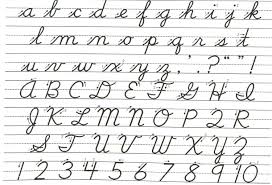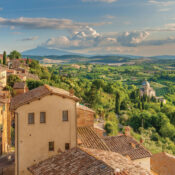For more about Gay Haubner’s life in the North Country, read the other chapters in her serialized memoir. The Post will publish a new segment each week.
Congdon was a big red brick pile built in 1929 and unchanged since. My second grade class still had wooden desks with ornate cast iron sides, holes in the upper right hand corner for inkwells, and decades of names scratched into the surface, even though making yet another mark on your desk was a major sin, practiced exclusively by boys. Heating vents honey-combed the building, just big enough for a child to crawl through. Everyone knew of a former student who had traveled the vents from the basement to the second floor. As the smallest kid in my class, I was egged on by my peers to repeat this journey; I bravely crept in about three feet before scurrying back out to the light.
The school had a huge gym, which was transformed into a performance space for Congdon’s annual Christmas Concert, where students sang “Silent Night” and “Up on the Rooftop” and a hundred other carols while standing around a twenty-foot Christmas tree, surrounded by concentric circles of parents perched on ancient and shaky folding chairs. We practiced for weeks for this concert. The handful of Jewish kids were left on their own for hours on end in their classrooms, to read or draw or twiddle their thumbs.
One side of the gym was a high, deep stage; it was expressly forbidden to jump on the stage and hide behind the red velvet curtains. I only saw the stage used once, when we were trotted down to the gym for a slide show of some woman’s trip to Korea, Thailand, and Cambodia. What a wonder! Someone from Duluth had actually gone to Asia! (A few years later, my paternal grandparents went to Hong Kong; my grandmother smuggled back an entire custom-made wardrobe by wearing all her new suits and dresses and coats on top of each other.)
The gym was a place of dread for me. I hated every gym class, including square dancing (which seems to have been a mandatory part of PE at all elementary schools in the country then), but apparatus day set me quaking in fear. When not in use, the “apparatus” was hung about the walls of the gym like instruments of torture. The rings weren’t so bad, I could hang by my knees forever, enjoying the rush of blood to my head, until I was kicked off by the next kid in line. But there were also climbing bars, which required chin-ups at the top, the ropes (how could it have been thought okay to send kids ten feet up in the air clinging to a rope so splintery it would have been rejected by the most horny-handed sailor, below only a mouldering two-inch-thick gym mat held together with duct tape to soften the fall?), and worst of all, the horse. My version of a vault was to run up to the horse, come to a dead stop, then heave myself over, struggling to land on my feet instead of my head.
All of our gym activities were overseen by our classroom teachers, who were uniformly unmarried, over fifty, and in varying degrees of unfitness, the worst being Miss Johnson, my fifth grade teacher, who was Mrs. Sprat fat. Our principal, Miss Brown, was of the same graying spinster ilk. The only masculine figure at Congdon was Mr. Swan, the janitor, who took the gym apparatus up and down, flooded and swept the Congdon ice rink in winter, and who could usually be found smoking a vile cigar down in the boiler room, poking at the roaring coal-burning furnace. Any classroom accident or breakage required someone to go down to that dungeon and bring back Mr. Swan with his mop and bucket. I always tried to hide beneath my raised desktop rather than have to face that scary man in his den. For any other errand, when a teacher asked for a volunteer, my hand shot up first.
A school telephone system had once been in place, as there were rudimentary black Bakelite and brass phones on the classroom wall, but they had long ceased to function, so students were sent as messengers back and forth, a wonderful chance to dawdle in the deserted halls, take a long gulp of cold water from the fountain, and hang around the principal’s office in hopes of seeing some bad boy brought in by the scruff of his neck to face Miss Brown.
Supply Monitor was the most prestigious and sought-after job, responsible for fetching chalk or construction paper each morning from the school’s supply room. I was often awarded this plum position; I was well-behaved, quiet, and a model student, which did not win me any friends.
I sailed through second grade, except for two subjects. We were now expected to stop printing in pencil and learn cursive writing, including the weird capitals S, Q, and G that bore no resemblance to their print counterparts. All of the letters in a word were supposed to flow from the pen, all connected smoothly at the bottom, with the top of lower-case letters exactly touching the dotted line bisecting each row. Not only did this require a level of manual dexterity I would never have, we also had to write with a fountain pen. Each student was given a brightly colored plastic pen, perfect to chew on, and a small supply of cylindrical ink cartridges. I was unable to insert the cartridge in the pen without exploding blue ink everywhere. My mother would shake her head at my stained dresses and my unvarying “C” in penmanship, which would probably have been a D if I didn’t get A’s in everything else.
 I also could not learn to tell time. Periodically during the school day we were required to look at the wall clock and write down the time. After weeks of failing to identify 10:30 or 1:45, it was discovered that I couldn’t see the hands of the clock. I was now the youngest, smallest, and only second grader with glasses. From the meager selection of children’s glasses at the eye doctor, I had picked out pale blue cat’s eyes, with silver sparkles at the corners to make a bad situation even worse.
I also could not learn to tell time. Periodically during the school day we were required to look at the wall clock and write down the time. After weeks of failing to identify 10:30 or 1:45, it was discovered that I couldn’t see the hands of the clock. I was now the youngest, smallest, and only second grader with glasses. From the meager selection of children’s glasses at the eye doctor, I had picked out pale blue cat’s eyes, with silver sparkles at the corners to make a bad situation even worse.
A few Congdon kids went home for lunch, most of us ate in the cafeteria at long wooden tables. Four days a week I got the “hot lunch,” which I retrieved on a tray from a small opening in the front of the cafeteria that gave way into a dimly lit kitchen ruled by mysterious lunch ladies. There was “lunch money” and “milk money,” which we had to remember to bring to school every Monday. Milk money went to buy waxy containers of milk to drink if you brought your soup and sandwich in a tin lunchbox that proclaimed your favorite TV show. This milk always tasted funny compared to our milk at home, which was delivered in glass bottles topped with paper discs labeled Springhill Dairies. Two or three times a year, there would be the miraculous appearance of cartons of chocolate milk, which we fell upon like wolves. On Fridays, to accommodate the few Catholic students who could not eat meat, lunch was always tuna noodle casserole, the noxious smell of which made me so nauseated I could barely eat my sandwich of red jelly on white bread.
Featured image: Shutterstock
Become a Saturday Evening Post member and enjoy unlimited access. Subscribe now




Comments
I am really loving this series❤
I was in Burbank, California, but with the exception of the ice rink, our stories are so similar. The recalling of “apparatus days” just twiddled a memory so forgotten. Who would imagine today that I had routines on each of the implements of torture–the parallel bars, the balance beam, the vault and the rings. Eee gads!
I love my Thursday night reading material, keep it up Gay!
Wow——such vivid memories. I came to Congdon as a second grader in Mrs. Kettner’s class——-she was soooooo kind! Miss Johnson(1964) had a Kleenex or hankie stuffed up her sleeve that she retrieved and used often and then shoved it back up her sleeve…..I remember her looking like Aunt Bea from the Andy Griffith show.I served as one of the school store check out gals and recall what a privilege that was……Gay, your description of the ropes was soooooo accurate—–I had horrid dreams and anxiety about the pressure to climb…..I got one third of the way up and had the worst rope burn ever coming down….and don’t forget the awful gym suit…wasn’t it a one-piece blue thing that flattered absolutely no figure. In 5th and 6th grade I was part of the first groups to be part of an experimental system of ‘rotating’ to different classrooms w/ teachers that specialized in that subject—we hauled ‘tote trays’ around from class to class and felt quite grown up. Mr. Downs was the Social Studies teacher and was quite good. Mrs. Briske was the language arts teacher and we had those SRA reading cards and self-administered them——I learned to scan quickly and read fast with those reading machines. The most dramatic memory was the day in 1963 when President Kennedy was shot and school was dismissed early—-my sisters and I walked the mile home even those we were usually ‘bussers’—-the adults were sooooooo sad and there was a ‘hush’ everywhere. Thanks for the memories!
I too attended Congdon Park. While I was a walker, I often was allowed to buy hot lunch on Fridays, when the alternative to tuna casserole was tomato soup with the most gooey, buttery grilled cheese sandwich. My greasy fingerprints left marks on everything I touched for the rest of the day, as good hygiene was not a priory it for me until I discovered boys in about fourth grade. Like Gay, I remember the ropes and bars and gymnastics’ apparatuses such as rings and the God-awful pommel horse as instruments of torture, but I also remember the transformation of the gym into a winter wonderland at Christmas, with the ceiling-high tree bedecked with sparkling Christmas lights that danced in the eyes of the children encircling its base. And the teachers? I remember them all! I liked them all. Mrs. Peterson, my second grade teacher, wrote on my report card, “Lois would rather help her classmates do their work than do her own work.” She was correct! From the day I first entered Congdon Park, I wanted to be a teacher. And that is just what I became. I taught English and journalism and was a high school principal for thirty five years. I never regretted one minute of it. Congdon Park was a perfect place to begin my career as an educator.
Ahhh! Mary Brown! While my children (Gail and Gordy Blum) were at Congdon, the good principal and I had several telephone conversations! Miss Brown once telephoned me to announce that sixth grader Gail was to be banned from chorus as punishment for a misdeed. The misdeed: Gail had organized a petition to remove a student teacher from the 6th grade gym class for bullying behavior. My disingenuous reply: “But Miss Brown, it’s the American Way! A petition is a way for a group of people to protest democratically! I think Gail did the right thing!” I WAS SO PROUD OF MY DAUGHTER!
Thanks for the memories! I was a few years behind you, as I started kindergarten at Congdon Park in 1969. I can still taste the weird milk and also the smell of school paste that was doled out of a big jar for art activities. As the shyest kid I was terrified of going to the “school store” to buy an eraser from the big sixth grade girls. Square dancing was the only part of gym I could handle – the ropes filled me with dread every year. I remember being in awe of the giant Christmas tree in the gym and filing into the risers to sing “Let There Be Peace on Earth” at the spring concert. We brought our ice skates in the winter and skating during recess or after school once the rink was ready.
I remember working for Mrs Liljecrans (SP?) as a lunch monitor. I had to collect and punch the hot lunch tickets. I loved Mrs Liljecrans. She taught me to eat spinach (I love it to this day.) Miss Johnson was crazy and senile by the time she taught my fourth grade class. I think she was retired after that year. The ropes in the gym were my nemesis as well. Never could climb one. Love your memories!
Right on Gay! Miss Johnson was a treat:) I also hated those stupid ropes and still can’t do a push up. Remember the mosaic sailing ships as a backdrop to the drinking fountains?
As one who attended Congdon Park with Gay, this brought back memories…memories I hadn’t thought of for years.
i think they came back so vividly because of both how accurately and marvelously she told the story. I can smell the smells. I can remember the milk not just from the cafeteria, but also from the huge, purple vending machine (2 cents a carton) on the east end of the 2nd floor.
Great piece. I can hardly wait to read more. Thank you, Gay Haubner…and thank you, Saturday Evening Post.
Chester Park Elementary for me. How could you not love the square dancing? Do si do, alemande left, swing your partner called by the teacher to peppy music was joyous. I too had “issues” with telling time, but my difficulty in first grade was not eye sight. I just didn’t get which hand was supposed to go where on the little cardboard clocks. This became my early introduction to cheating. Yes, I admit it. And I never forgot the guilty feeling – even 60 years later. To make matters worse, I adored my young, unmarried teacher, Miss Waxelbaum. She even walked home with me for lunch one day. I can clearly remember the two layer cake my mother made, with white iceing decorated with daisies from the garden.
We also have different impressions of gym class. The ropes were an exercise in futility as my body could not get any higher then resting on the big bottom knot. On the other hand the horse was a snap and I loved running and flying over it, legs extended.
But I guess my worst moment must have been in kindergarten. Luckily, I have no memory of this at all, but my best friend Susie, loves to retell it. Evidently, during show and tell I lifted up my dress and said, “See my new slip”. Had I no shame? But all’s well that end’s well and eventually I graduated from Chester Park, with the big grandfather clock directly inside the front doors, and made my way to brand new Woodland Junior High.